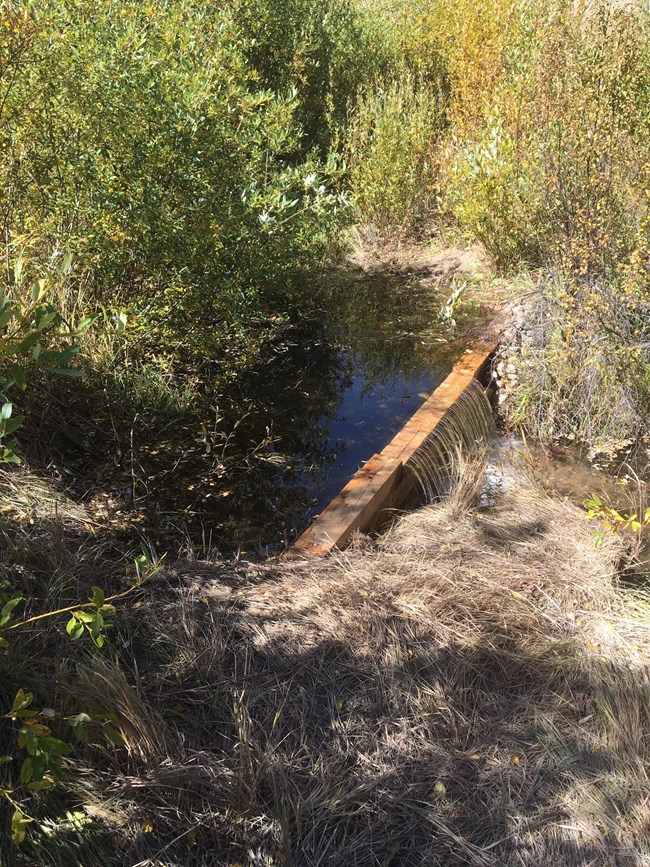Last updated: November 7, 2022
Article
Simulated Beaver Structures
Frequently Asked Questions

NPS/C Turner
In September 2019, simulated beaver structures (SBS; also known as beaver dam analogs) were constructed along two streams in Rocky Mountain National Park (RMNP). SBSs are human constructed features that function like a beaver dam— they slow the movement of water, create pools behind the features, and allow for higher rates of sediment deposition within the pool. Ultimately, they are a tool for adding complexity to a stream, helping to restore wetlands and increase biodiversity within a riparian area. Here at RMNP, they support the park’s adaptive management approach to habitat restoration under the Elk and Vegetation Management Plan (EVMP).
What are the SBSs made of? Are they permanent?
SBSs can be constructed out of a variety of materials. Here at RMNP, they were constructed using un- treated lumber. A trench was dug across the stream channel approximately two foot beyond the stream bank on both sides, and approximately six inches below the stream bed. Six inch by six inch boards were cut to size, stacked and secured together with long screws. The SBSs were further secured in place using the dirt and rocks originally removed during the digging of the trench. Two SBSs were construct- ed at each site, with approximately 25 yards between the upstream and downstream structures. Shallow notches, the width of the stream, were cut in the top board to direct stream flow to the middle of the channel and prevent breaching beyond the stream channel.
The structures are not meant to be permanent and will be evaluated over time.
Why was this project started? What are the expected benefits?
The 5-year review of the EVMP found variability in willow response inside elk exclosure fences. With elk browsing pressure greatly reduced, the lack of positive response in some areas was concerning. Hydrological conditions, particularly low water tables, were suggested as the most likely reason. Beavers, recognized as ‘ecosystem engineers’, build dams which work to raise local water tables, slow water flow, increase sediment deposition in stream channels and floodplains, increase overbank flooding and encourage channel movement. This in turn creates and enhances wetland habitat. It is anticipated that the SBSs will have a similar effect within RMNP.SBSs have been used successfully in other locations, including Yellowstone National Park and Cheley Camp outside of Estes Park.
Why not introduce beaver instead?
Ecologically, beaver are needed to build and maintain the healthy wetland communities historically found in the park. Beaver were abundant historically in these areas and reintroduction was included as one of many possible actions as part of the EVMP, but currently there are no specific plans in place to implement beaver reintroduction. At this time, beaver would put additional pressure on willow and aspen that the park is trying to restore.
It is anticipated that beaver will naturally re-colonize areas of the park as wetland habitat is restored. While there is evidence that beaver have travelled through targeted areas of the park, they do not seem to stay, suggesting that the habitat is not adequate. Through wetland enhancement, SBSs may encourage long-term recolonization by beaver.
How will you know if the SBSs are working?
Pre-construction baseline monitoring was started during the summer of 2018. Data loggers record stream depth, water table level and fluctuations, and overbank flooding events and water flow direction. Field visits by collaborating scientists measure sedimentation within the floodplain and identify and measure vegetation within defined vegetation plots. Sound recording devices are used to measure biodiversity at the site. This monitoring will continue post-construction to see if there are improvements in hydrology, willow regeneration, and biodiversity.
Are there plans to add more SBSs if they prove successful?
A third location at a site with higher stream flow also has been proposed and may be installed in fall 2020 depending on the outcome of the initial four installations. If successful, more locations may be proposed in the park.
Who is involved in the project?
This project involves multiple NPS and academic partners. RMNP staff from the Resource Stewardship Division have been working with NPS Inventory and Monitoring staff and academic researchers from Colorado State University who specialize in wetland ecology, stream ecology and habitat restoration. Each party brings a wealth of skills, experience and expertise to the project.
Continental Divide Research Learning Center
